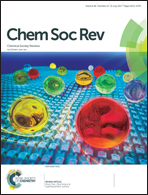Dye-sensitized lanthanide-doped upconversion nanoparticles†
Abstract
Lanthanide-doped upconversion nanoparticles (UCNPs) are promising for applications as wide as biological imaging, multimodal imaging, photodynamic therapy, volumetric displays, and solar cells. Yet, the weak and narrow absorption of lanthanide ions poses a fundamental limit of UCNPs to withhold their brightness, creating a long-standing hurdle for the field. Dye-sensitized UCNPs are emerging to address this performance-limiting problem, yielding up to thousands-fold brighter luminescence than conventional UCNPs without dye sensitization. In their configuration, organic dyes with spectrally broad and intense absorption are anchored to the surface of UCNPs to harvest the excitation light energy, which is then transferred via Förster and/or Dexter mechanisms across the organic/inorganic interface to the lanthanides incorporated in UCNPs (with or devoid of a shell) to empower efficient upconversion. This tutorial review highlights recent progress in the development of dye sensitized UCNPs, with an emphasis on the theory of energy transfer, the geometric classification of the dye sensitized core and core/shell nanocrystals, and their emerging photonic and biophotonic applications. Opportunities and challenges offered by dye sensitized UCNPs are also discussed.



 Please wait while we load your content...
Please wait while we load your content...